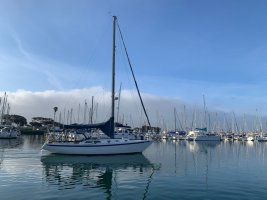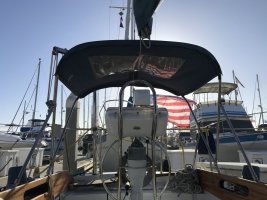I'd never get away with it!
But seriously folks, the 35-III is a faster boat than the -II.
In most conditions it should be faster roughly in accordance with the rating difference.
The trick, as Loren alluded to, is that these statements are based on some assumptions: The boats have fresh sails and are using appropriately sized sails for a given wind condition and angle; they are not overloaded, and are loaded correctly; and they have clean bottoms.
These conditions are rarely met except by race boats, and despite what the bare facts of the 2 designs suggest, I can imagine many conditions where a -II would be faster than a -III.....
How about 12 knots TWS at a TWA of 160 degrees... The -II is flying a full sized .75 oz spinnaker, staysail and full main, while the -III is flying a furling 135% genoa and mainsail in the same conditions. Guess which is going faster?
On another topic, someone was commenting on weight placement having a big effect on pitching moment for their 38, and how he could tell the difference when he had anchor chain in the bow-the boat was slower and would pitch a lot in the waves.
Great observation, and this is true for any boat. As convenient as those bow lockers are, if you are racing you simply cannot afford to put ANYTHING in there. There is a significant performance penalty on any boat when you sail with weight in either end (although the bow is usually more sensitive), so when racing, you should not only remove any weight from the boat you can, but make sure you empty to bow locker, fwd tanks, and the aft cockpit lockers (as much as you can). I put the anchors, chain and rode in a sail bag on the cabin sole right on top of the keel when racing.
This is certainly not unique to Ericson designs, and any performance oriented cruising desgn will behave the same way-it is just physics.
Most folks are willing to sacrifice some performance when cruising or day sailing for the conveneience of these features, but one must accept the impact this will have on performance-the same way your car is a bit more sluggish off the line and around the corners when fully loaded.
Sorry for trying to cover both issues here, but it seemed like a good fit.
Don't forget to tip your waitress!




